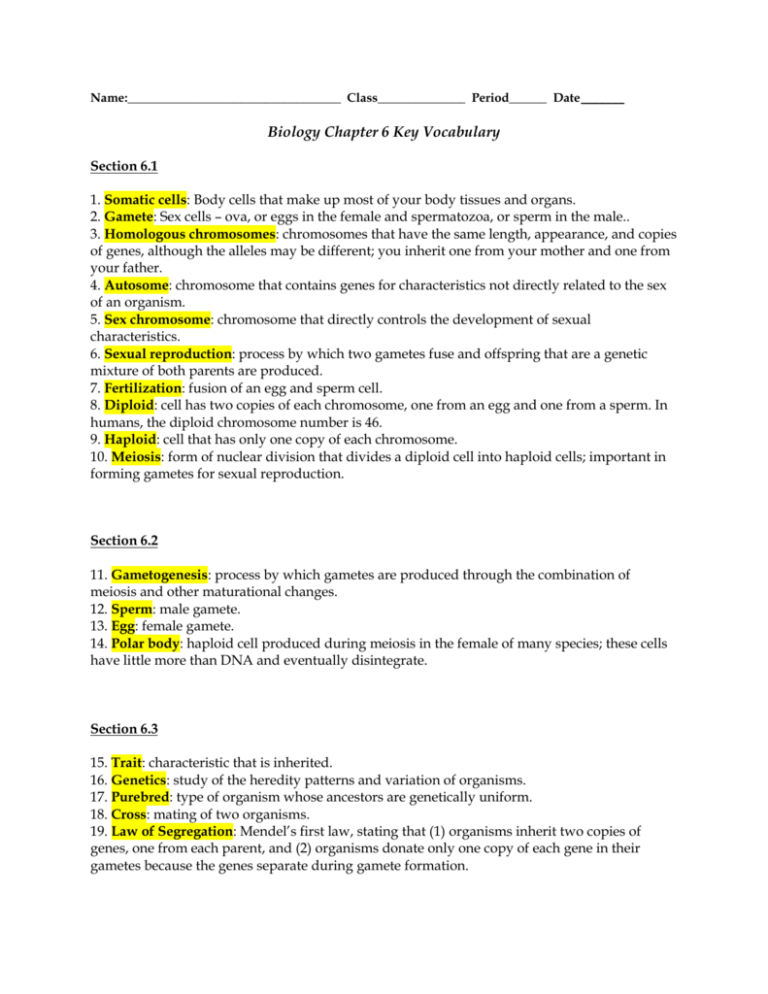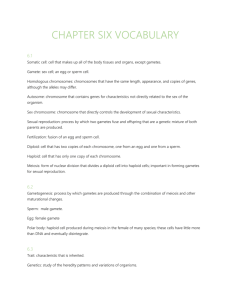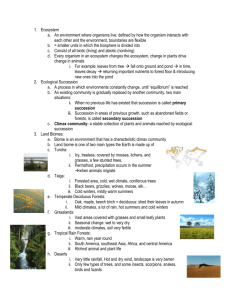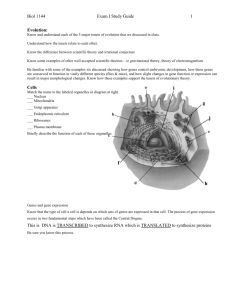Biology Chapter 6 Vocabulary: Key Terms & Definitions
advertisement

Name:__________________________________ Class______________ Period______ Date_______ Biology Chapter 6 Key Vocabulary Section 6.1 1. Somatic cells: Body cells that make up most of your body tissues and organs. 2. Gamete: Sex cells – ova, or eggs in the female and spermatozoa, or sperm in the male.. 3. Homologous chromosomes: chromosomes that have the same length, appearance, and copies of genes, although the alleles may be different; you inherit one from your mother and one from your father. 4. Autosome: chromosome that contains genes for characteristics not directly related to the sex of an organism. 5. Sex chromosome: chromosome that directly controls the development of sexual characteristics. 6. Sexual reproduction: process by which two gametes fuse and offspring that are a genetic mixture of both parents are produced. 7. Fertilization: fusion of an egg and sperm cell. 8. Diploid: cell has two copies of each chromosome, one from an egg and one from a sperm. In humans, the diploid chromosome number is 46. 9. Haploid: cell that has only one copy of each chromosome. 10. Meiosis: form of nuclear division that divides a diploid cell into haploid cells; important in forming gametes for sexual reproduction. Section 6.2 11. Gametogenesis: process by which gametes are produced through the combination of meiosis and other maturational changes. 12. Sperm: male gamete. 13. Egg: female gamete. 14. Polar body: haploid cell produced during meiosis in the female of many species; these cells have little more than DNA and eventually disintegrate. Section 6.3 15. Trait: characteristic that is inherited. 16. Genetics: study of the heredity patterns and variation of organisms. 17. Purebred: type of organism whose ancestors are genetically uniform. 18. Cross: mating of two organisms. 19. Law of Segregation: Mendel’s first law, stating that (1) organisms inherit two copies of genes, one from each parent, and (2) organisms donate only one copy of each gene in their gametes because the genes separate during gamete formation. Section 6.4 20. Gene: specific region of DNA that codes for a particular protein. 21. Allele: any of the alternative forms of a gene that occurs at a specific place on a chromosome. 22. Homozygous: characteristic of having two of the same alleles at the same locus of sister chromatids. 23. Heterozygous: characteristic of having two different alleles that appear at the same locus of sister chromatids. 24. Genome: All of an organism’s genetic material. 25. Genotype: collection of all of an organism’s genetic information that codes for traits. 26. Phenotype: collection of all of an organism’s physical characteristics. 27. Dominant: allele that is expressed when two different alleles are present in an organism’s genotype. 28. Recessive: allele that is not expressed unless two copies are present in an organism’s genotype. Section 6.5 29. Punnett square: model for predicting all possible genotypes resulting from a cross, or mating. 30. Monohybrid cross: cross, or mating, between organisms that involves only one pair of contrasting traits. 31. Testcross: cross between an organism with an unknown genotype and an organism with a recessive phenotype. 32. Dihybrid cross: cross, or mating, between organisms involving two pairs of contrasting traits. 33. Law of Independent Assortment: Mendel’s second law, stating that allele pairs separate from one another during gamete formation. 34. Probability: Likelihood that a particular event will happen. Section 6.5 35. Crossing over: exchange of chromosome segments between homologous chromosomes during meiosis I. 36. Genetic linkage: tendency for genes located close together on the same chromosome to be inherited together.











